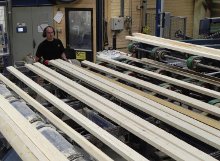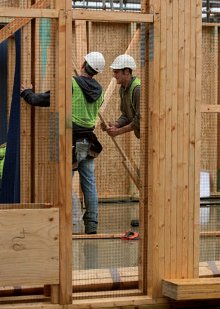UK buyers lack confidence to look beyond short term
5 October 2013Demand from the UK’s building sector is increasing but, while the timber industry expects trade to improve next year, longer-term confidence is still lacking
A widespread log shortage at north European sawmills has caused a reduction in production volumes which, in turn, has created substantial gaps in shippers' specifications.
This has forced many UK buyers to scour landed stocks to plug gaps in their inventories. Late shipments and limited forward offers have exposed the UK and some of its Continental counterparts as under-bought markets, creating a situation where importers are seeking to trade with each other in both carcassing and joinery redwood specifications to supply customers.
The situation follows a downturn of more than 6% in global softwood exports from Sweden in the first seven months of 2013, and a longer-term reduction in production of approximately 5% over the 12-month period to the end of August. Within the figures, exports to the UK alone were down more than 4.5%, but were stronger in comparison with the first and second quarters. These quarters reflected drops of over 9.5% and 7.5% respectively against the same periods in 2012; and by the end of June 2013, UK imports of Swedish softwood had fallen by more than 135,000m³ from 2012 levels.
Sweden's exports to both European and African markets fell in the seven months to the end of July, but rose sharply in the Asian markets - with sales to China in triple-digit figures and emerging markets in South Korea and the Yemen at almost 50% and 100% respectively. The significance of growth in alternative markets is the price, as shippers are enjoying better returns from these players than from their traditional buyers.
As a result of increased fibre costs, carcassing prices at the mills have been inching up steadily, and although prices in the UK have been rising as importers seek to secure forward volumes, they have not yet reflected the full level of replacement costs.
While Swedish volumes have reduced, producers in the Baltic region increased exports to the UK in the first half of 2013, with Latvia increasing its market share by around 2%. Log supplies in the Baltic states are critically low at many mills, and prices have been pushed higher - due largely to the aggressive sourcing activities of Chinese buyers. Even though China imported over 4.5 million m³ of roundwood from the Russian Federation in the first half of the year, the volume was approximately 15% below the same period in 2012. In the full year of 2011, China imported virtually 14 million m³ of Russian logs for processing, so with an ever-increasing requirement for raw fibre, Chinese buyers are likely to continue bidding for fibre against local mills wherever they can in northern Europe.
In Latvia, there is more pine than spruce in the commercial forest regions, and under normal market conditions a lower price is usually paid for redwood logs, which usually end up as treated carcassing to avoid discolouration. In the current climate, however, the cost differential between the species has narrowed because forest owners are seeking to bring the price of pine logs closer to that of spruce. One shipper recently commented that his suppliers had offered mixed batches of pine and spruce logs priced at the full whitewood level.
Looking ahead to 2014, buyers in the UK and elsewhere can expect a higher percentage of redwood from Baltic producers on a more permanent basis. Fortunately, the UK consumes a higher volume of preservative treated carcassing (approximately 70%) than untreated, so provided the grading of redwood is to standard and discolouration is not rife, this will not prove to be an issue.
British-grown sector
In the home-grown industry, sawmills continue to benefit from sterling's weakness against the euro and Swedish krona, and the downturn in exporters' output. Nearly all the home-grown producers are fully sold in both C16 and ungraded softwood, with lead-ins being extended every week.
As supplies have tightened, so UK demand has shown signs of an improvement. This has centred on a rise in new house building, and at the half-year, both public and private construction increased by almost a third against 2012 levels. The big question for the softwood industry is: what effect will these figures have on demand for solid wood? A substantial portion of house construction is now specified as engineered wood products and the use of I-beams is expected to further reduce demand for solid joists on an ongoing basis.
Although an increase in general demand is likely to have a positive effect on the use of softwood, it is uncertain by how much. Several merchants have confirmed an increase in demand from the building sector, but they also make the point that shortages in other materials such as bricks, combined with a shortage of skilled labour on site, are holding back call-offs and deliveries of timber.
While the rise in new housing is being boosted by finance schemes for first-time buyers, demand from the repair and home improvement sector has remained in decline. This market uses a higher proportion of softwood for both structural and decorative purposes, including solid wood skirting and architraves (as opposed to profiled MDF). Some merchants have reported increased signs of activity in the RMI market, but also say trade fell away again in the last two weeks of September.
There is speculation that the current rise in UK property values may induce more people to improve their houses and add extensions but, for the time being, a great deal of uncertainty hangs over this market sector - especially as it is an acutely regional situation, mostly attributable to properties in south-east England.
In contrast to the tightening supply of structural carcassing from export mills, joinery redwood imports to the UK strengthened in the first six months, albeit by only 1%.
Finnish redwood production reached around 3.3 million m³ in the eight months to the end of August, a rise of 4% over last year's figure. In August alone, production was up by 5% to an estimated 410,000m³. Swedish redwood production fell by 3% over the same period and was down 5% in the month of August at just over 500,000m³.
A noticeable effect from the cutbacks in Swedish production is a shortage of 22mm whitewood boards, which is forcing importers to search every supply market to satisfy demand. In the first six months of this year, total UK softwood imports from all sources were down to just below 6% but, with a rise in demand,
imports could rise again by the year-end. Much will depend on log availability and production levels. Particular emphasis will be placed on the performance of the Swedish mills, but nobody wants to see production ramped up too far too quickly, in what is still a finely balanced and quite complex market.
The industry holds an expectation that trade will improve in the UK in 2014, with a possible economic recovery taking place if analysts' current figures prove to be correct. Longer-term confidence is still a missing ingredient in the UK though and, until companies see a sustained period of growth, the market will continue to operate on a short-term cycle, with softwood buyers keeping stocks tight and avoiding large forward commitments.

